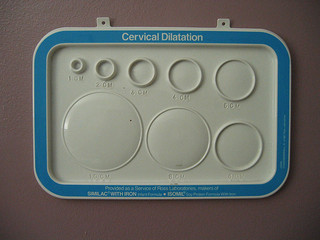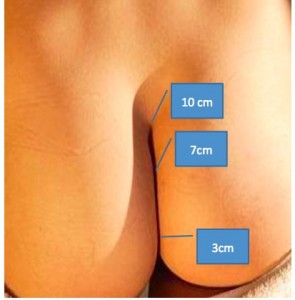July 02, 2014
The Red/Purple Line: An Alternate Method For Assessing Cervical Dilation Using Visual Cues
By: Mindy A. Cockeram, LCCE | 0 Comments
By Mindy Cockeram, LCCE
Today's blog post is a repost of one of the most popular posts ever shared on our blog. It is written by Mindy Cockeram, LCCE. Mindy explores the 'mystical' red/purple line that has been observed to provide information about cervical dilation without the need for a vaginal exam. Have you seen such a line. Do you have other ways of identifying dilation that do not involve cervical exams? Please share in the comments- Sharon Muza, Science & Sensibility Community Manager.
When couples in my classes are learning techniques for coping in labor, such as the Sacral Rub (sacrum counterpressure), Double Hip Squeeze and Bladder32 accupressure points, I always talk about the great position the partner is in for spotting the red, purple or dark line (depending on skin color) that creeps up between the laboring woman's buttocks and how - by 'reading' that line - he or she may be able to assess more accurately the woman's cervical progress than the health care providers! This empowering thought is often met with smiles and laughter especially when I translate 'natal cleft' into more recognizable words like 'butt cleavage'. Strangely, I've never had anyone in class mention having heard of this 'thermometer' for accessing cervical dilation by sight and I find this interesting considering the number of medical professionals that come through my classes.

Photo CC
http://www.flickr.com/photos/alexyra/214829536/
I first came across this body of research as an Antenatal Student Teacher with the National Childbirth Trust in London. The article I was reading was in Practising Midwife and was a 'look back' at the original article (Hobbs, 1998) published in the same magazine. The original Practising Midwife article was based on a letter referencing a small study by Byrne DL & Edmonds DK published in The Lancet in 1990.
In the 1990 letter to The Lancet, Byrne and Edmonds outlined and graphed 102 observations from eighteen midwifes on 48 laboring women. It states 'The red line was seen on 91 (89%) occasions, and was completely absent in five (10.4%) women and initially absent in three (6.25%).' The report then goes on to talk about the 'significant correlation between the station of the fetal head and the red line length.' Later the authors write: 'To our knowledge, this is the first report of this red line. We believe that it represents a clinical sign which is easy to recognize and which may offer valuable information in obstetric management.'
So how does this line work? And why does this it appear? Practising Midwife Magazine presented a graphic which I have attempted to recreate here. Basically as the baby descends, a red/purplish (or perhaps brown depending on skin color) line creeps up from the anus to the top of the natal cleft in between the bottom cheeks. When the line reaches the top of the natal cleft, 2nd stage is probably a matter of minutes away. A line sitting an inch below the natal cleft is probably in transition. A line just above the anus probably signifies early labor.
Byrne DL & Edmonds DK, the authors of the original study, surmise that the cause of the line is 'vasocongestion at the base of the sacrum.' Furthermore, the authors reason that 'this congestion possibly occurs because of increasing intrapelvic pressure as the fetal head descends, which would account for the correlation between station of the fetal head and red line length.' Fascinating and logical!
Interestingly, I came across a 2nd Scottish study from 2010 published by BMC Pregnancy & Childbirth: (Shepherd A, Cheyne H, Kennedy S, McIntosh C, Styles M & Niven C) which aimed to assess the percentage of women in which a line appeared (76%. ) The study cited only 48-56% accuracy of vaginal examinations to determine cervix diameter and fetal station. So why aren't clinicians using this less invasive visual measure - especially considering how much some women may dread vaginal exams in labor?? Wouldn't the thought of using a methodology to lower infection rate after rupture of membranes has occurred enthuse Health Care Providers instead of using higher risk techniques? Or how about using the accuracy of the line at the natal cleft to know when a women using epidural should really be coached to push?
My educated guess is that this information has not yet reached Medical Textbooks and non-standard practices can take years to become mainstream (for example. delayed cord clamping) - and then only if or when women request them or media sensation activates them. In addition, since laboring women are only intermittently attended by Labor & Delivery staff during early and active labor and often encouraged to 'stay in bed,' Health Care Providers aren't necessarily faced with a woman's buttocks in labor. Also vaginal examinations are considered 'accurate' so staff have no need to peek between a woman's natal cleft. However both these studies, paired with the roughly 50% accuracy rate of manual vaginal exams, show that there is potentially a more accurate and less invasive way ahead.
In The Practising Midwife (Jan 2007, Vol 10 no 1, pg 27), Lesley Hobbs writes 'Accurate reading would seem to the key to this practice. I sometimes notice in myself a wish to see the line progressing more quickly than it actually does; when I do this - and check with a vaginal exam - only to find the line is right, I get annoyed with myself and wish I'd trusted my observations.' Later she goes on to say 'I can now envisage a time when I shall feel confident enough to use this as my formal measurement mechanism and abandon intrusive and superfluous vaginal exams.'
Licensed Midwife Karen Baker from Yucaipa, CA commented 'The purple line is a curious thing. It's definitely not present on everybody but is more prominent on some than others - especially right before pushing. It tells us when she's in full swing if we are in a good position to spot it!'
I often urge couples to send me a picture of the so called 'purple line' which I promise I will use only for educational purposes but so far a picture is as elusive as the Loch Ness Monster. So, as I say in class, 'show me your purple line'!
Are you a midwife, doctor, nurse or doula who has observed this in a client or patient? Partners, have you seen this when your partner was in labor? Has anyone heard of it or witnessed it? If you are a childbirth educator, do you feel this is something that you might mention in your classes? Do you think that the families in your classes might be likely to ask for this type of assessment if they knew about it? Please comment and share your experiences.
References
Byrne DL, Edmonds DK. 1990, Clinical method for evaluating progress in first stage labour.Lancet. 1990 Jan 13;335(8681):122.
Downe S, Gyte GML, Dahlen HG, Singata M. Routine vaginal examinations for assessing progress of labour to improve outcomes for women and babies at term (Protocol). Cochrane Database of Systematic Reviews 2012, Issue 9. Art. No.: CD010088. DOI: 10.1002/14651858.CD010088.
Hobbs 1998. Assessing cervical dilatation without Vaginal Exams. Watching the purple line. The Practising Midwife 1(11):34-5.
About Mindy Cockeram
 Mindy Cockeram is a Lamaze Certified Childbirth Educator teaching for a large network of hospitals in Southern California. She has a BA in Communications from Villanova University and qualified as an Antenatal Teacher through the United Kingdom's National Childbirth Trust (NCT) in 2006. A native of the Philadelphia area, she spent 20 years in London before relocating to Redlands, CA in 2010.
Mindy Cockeram is a Lamaze Certified Childbirth Educator teaching for a large network of hospitals in Southern California. She has a BA in Communications from Villanova University and qualified as an Antenatal Teacher through the United Kingdom's National Childbirth Trust (NCT) in 2006. A native of the Philadelphia area, she spent 20 years in London before relocating to Redlands, CA in 2010.
Tags
Childbirth education Second Stage Midwives Labor/Birth Cervical Dilation Mindy Cockeram Purple Line